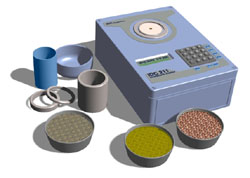Laboratory MICRORADAR -
101.2 moisture meter
Description
The MICRORADAR 101.2 moisture meter is designed
for the rapid analysis of water content in
powders and granules, and provides measurements
that are insensitive to sample preparation,
including variations in bulk density. Samples are
simply poured into an appropriate measurement cup
(supplied) which is then positioned on the meter,
and the moisture content indicated on the digital
display. Pre-set calibrations for different
materials can be entered into the computer
memory, making this a versatile device for a
range of materials. The MICRORADAR 101.2 moisture
meter is suitable for the measurement of a
variety of materials, including sugar, sand,
chemicals, pharmaceuticals, and other materials
with low to super low moisture content. |
 |
| Figure 1 The MICRORADAR
101.2 moisture meter (showing sample cup options
for different materials and moisture contents) |
General Specifications
- Range of moisture measurement: typically within
0.01 to 16% (and depends on the type of material
being tested)
- Resolution, in % moisture: 0.01%
- Accuracy depends on material under test, and
generally increases with decreasing water content
and calibration range (see Table 2 overleaf)
- Memory for up to 10 calibrations*, for different
types of materials
- Measured water content is independent of bulk
density, particle size/shape.
- Sample volume : 40 to 50 cm3
- Wipe clean surfaces
- Reliable and robust
- Stable calibration
- Dust and water protected
- Frost-resistant indicators
- RS-485 interface for data logging to computer
* Number of calibrations may be
increased if the meter is connected to an IBM compatible
PC
How the meter works
The meter is based on an open-ended
resonator, in which the coupling of electromagnetic
energy between the test material and the meter is via the
fringing fields from the open resonator to the sample
cup. These fields act as an ‘effective’ capacitance and conductance, and determine the values of f
and Q for the resonator, which in turn can be
related to the moisture content of the material under
test, via predetermined calibration constants. These
calibration constants are remarkably stable, and are much
less dependent on sample preparation than alternative
measurement technologies, based on the direct measurement
of resistance/conductance or capacitance.
Table 1 Technical Specifications
| Parameter |
. |
| Weight of meter (kg) |
No more than three |
| Dimensions of meter (approx., cm) |
35 (h) x 22 (w) x 12 (depth) |
| Volume of sample cup (cm3) |
50 |
| Dimensions of sample cup (cm) |
D4 |
| Power supply (V) |
190/240 |
| Power consumption, max (W) |
40 |
| Display refresh rate, min (seconds) |
1 |
| Analogue output (mA) |
4-20 |
| Serial port standard |
RS-485 |
| Operation temperature range (° C) |
+5 to + 45 |
| Operation ambient humidity (%RH) |
40 to 98 |
 |
Figure 2
Sample cup options |
Table 2 Typical measurement ranges and
associated accuracy for different materials, as measured
by the MICRORADAR 101.2 moisture meter.
Accuracy is given as standard deviations (n = 10) of the
difference between the moisture meter reading and that of
the standard laboratory method (e.g. loss on drying or
Karl Fisher titration).
| Products |
moisture range
in % |
Accuracy
(Std.- deviation) in % |
| Tobacco |
|
|
cut-tobacco
|
10 - 15 |
+/- 0.2 |
cigarettes
|
10 - 15 |
+/- 0.2 |
cigars
|
10 - 20 |
+/- 0.2 |
| Coffee |
|
|
green
beans
|
8 -15 |
+/- 0.2 |
roasted
beans
|
3 - 6 |
+/- 0.15 |
grinded
coffee
|
3 - 6 |
+/- 0.15 |
instant
coffee
|
2 - 5 |
+/- 0.15 |
| Cocoa |
|
|
powder
|
1 - 14 |
+/- 0.15 |
| Sugar |
0.01 - 1 |
+/- 0.02 |
| Tea |
2 - 12 |
+/- 0.2 |
| Grain wheat,
rice,oat, maize |
|
|
corns
|
7 - 17 |
+/- 0.25 |
meal
|
10 - 15 |
+/- 0.15 |
| Milk powder |
1.5 - 7 |
+/- 0.15 |
| Casein,
Caseinat |
3 - 12 |
+/- 0.2 |
| Salts |
|
|
carbonates
|
0.1 - 0.5 |
+/- 0.03 |
sulfate
|
0.1 - 0.5 |
+/- 0.03 |
Nitrate
|
0.1 - 0.5 |
+/- 0.03 |
| Silicic acid |
2 - 5 |
+/- 0.05 |
| Alumina |
0 - 3 |
+/- 0.1 |
| Zeolit |
0.3 - 1.5 |
+/- 0.03 |
|

